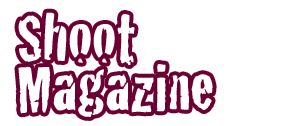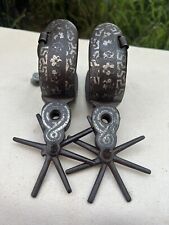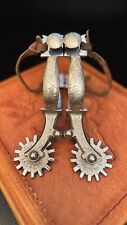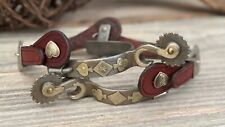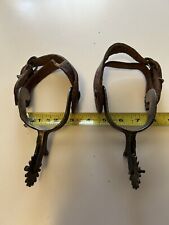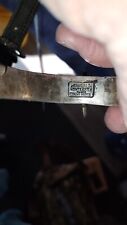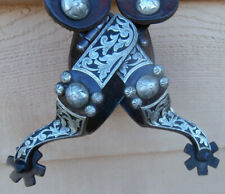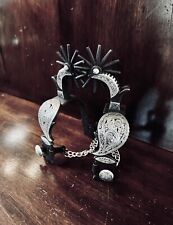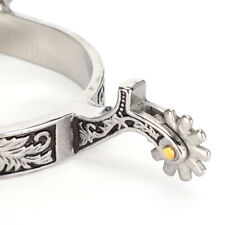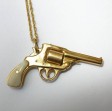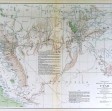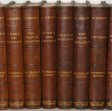SPURS – The jingle-jangle of silver spurs makes the West come alive
By: Cactus Tubbs
Circa 1880. As the warm wind rolls across the Great Plains, it pays a visit on the cowtown of Dodge City, Kansas. The aroma of the longhorn cattle rides piggyback in the wind. Late at night one lone man methodically checks store and shop doors as he walks across the echoing boards of the town’s boardwalks. Glimpses of his badge of office reflect in the glow of oil street lamps and the Kansas moon. The sound of each of his steps drowns out the howl of the wind. Each time a boot heel meets the wooden planks, a sharp “jingle” immediately follows. As he lifts the next foot for another step, a crisp “jangle” is clearly heard. This distinctive “jingle-jangle” can only mean one thing; Festus Hagin from “Gunsmoke” is filling my TV screen.
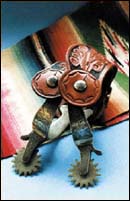 I will forever remember Ken Curtis’s character, “Festus” and his trademark “jingle-jangle” sound with each step. As a young lad growing up in West Texas, I would suspend after-school activities until after “Gunsmoke”. Dad and I would sit like two bumps on logs glued to the screen, waiting for Matt Dillon to nab the outlaw, or for Doc and Festus to have one of their famous and usually hilarious arguments. But I noticed early on that Festus had to have the loudest set of spurs north, south, east, and west of the Pecos. I get amused now when I watch an episode (EVERY Sunday thanks to satellite TV!) and Festus is “jingle-jangling” trying to sneak up on a bad guy. Somehow, even with those amplified spurs he manages to surprise his opponent.
I will forever remember Ken Curtis’s character, “Festus” and his trademark “jingle-jangle” sound with each step. As a young lad growing up in West Texas, I would suspend after-school activities until after “Gunsmoke”. Dad and I would sit like two bumps on logs glued to the screen, waiting for Matt Dillon to nab the outlaw, or for Doc and Festus to have one of their famous and usually hilarious arguments. But I noticed early on that Festus had to have the loudest set of spurs north, south, east, and west of the Pecos. I get amused now when I watch an episode (EVERY Sunday thanks to satellite TV!) and Festus is “jingle-jangling” trying to sneak up on a bad guy. Somehow, even with those amplified spurs he manages to surprise his opponent.
While I have no recollection of ever getting a good view of the spurs he wore in the series, had his spurs been “authentic” they likely would have been the “OK” style of spur. This type of spur was a very simplistic design and widely used throughout the West from 1880 through the 1930’s, inexpensive and practical to use and very functional. Literally thousands of these spurs were manufactured by one of the two large manufacturing companies; August Buermann of Newark, New Jersey, and North & Judd of New Britain, Connecticut. However, by the 1880’s a spur became an indicator of a cowboy’s status or a measure of his experience. Cowboys began seeking out more stylized spurs and the mass-produced spur began to give way to the custom-made set. The “OK” spur eventually became a sign of bad luck or inexperience.
“Buzz Saws,” “Gut Hooks,” “Cowboy Steel,” “Persuaders,” these are some of the colorful descriptions sometimes given to the cowboy’s spurs. But the spur dates back much farther than the 1880’s. In fact, some of the earliest spurs date back to 700 BC. By the 15th Century, spurs identified rank for Old World cavaliers, knights, and caballeros. Kings even awarded a horseman the “right” to wear spurs. The Spanish conquistadors introduced spurs to the New World by the 16th Century.
The early conquistador spurs were made of iron and had narrow heel bands, drooping shanks, and sizable rowels, six, eight and even up to ten inches in diameter. The spokes were long, narrow, and blunt.
As time passed, the sizeable large rowels began to diminish, and early metal artisans often replaced the spiky rowels with more of a serrated disk. The shanks also got shorter, and of course, engraving began to show up, as well as inlay of silver, brass, gold, and sometimes semi-precious stones. Often a “jingle-bob” or “dangler” was hung from the rowel, enhancing the “jingle-jangle” sound. I’m certain Festus had jingle-bobs on his spurs! But the fancy spurs were the exception, not the rule. Most early vaqueros and cowboys wore very simple spurs. The fancier the spur, the more it cost, although later a set of spurs often became a rather important part of the cowboy’s overall appearance.
While American cowboys initially wore Mexican spurs, it didn’t take long for specific styles to emerge distinguished by region. Texas-style spurs, made in Texas, Colorado, Kansas, and Oklahoma, were generally cruder than the California-style spurs from California, Nevada, and Oregon.
“In a general way, the latter were a trifle larger and silver-mounted, while the former lacked much of the ornament,” wrote Jo More in his book Trail Dust and Saddle Leather. Spurs that were developed in the Northern Plains often combined the styles.
California vaqueros were partial to their fancy spurs, which were generally of two-piece construction consisting of the shank and the heel band. The spurs were usually full-mounted with silver inlay on both sides of the heel band and shank. The engraved designs were intricate, the metal blued, and the edges of the heel bands often beveled. Often they featured fancy chap guards decorated with engraved spirals. Toward the later part of the 1800’s, G.S. Garcia was one of the most renowned of the California-style spur makers. He established his saddle shop in Elko, Nevada, in 1894. Mr. Garcia employed some of the most distinguished spur makers of the time. Garcia is best known for his Dandy patterns, which were advertised in his 1901 catalog as the “finest spur ever made with 100 different inlays.” It was double-mounted with the distinctive patterns of a pinwheel on one side and a diamond on the other and embellished with a 1¼ inlaid rowel. The most common marking on his spurs was the name “G.S. Garcia” inside the heel band of one spur and “Elko, Nev.” inside the other.
The Northern Plains and Great Plains spurs, which essentially combined elements from the California and Texas styles, were generally of one-piece construction and decorated with inlay or overlay, as well as silver conchos used on both the shanks and heel bands. Many of these spurs featured beautifully engraved surfaces and fine workmanship.
In the late 1800’s, Texas-style spurs were forged of one piece and were constructed with either swinging or stationary buttons, usually on turned-up heel bands. Often they were only half-mounted, featuring overlaid decorations on the outside of the band. Because these spurs were generally plainer and more utilitarian than the California spurs, they rarely featured chains or chap guards.
By the 1880’s, several Texas craftsmen started making fancier spurs, which in some collectors’ eyes surpassed the dashing style of the California spur. Two of the most distinctive spurs were the gal-leg and gooseneck. Considered the granddaddy of the Texas-style spur and the first in Texas to market a handmade spur, John Robert McChesney hammered his first spur out of forged iron in 1887. He ultimately opened the McChesney Bit & Spur Company in Pauls Valley, Oklahoma after working in Gainesville, Texas. His company became a respected leader in the business nationwide. Some credit him for the gal-leg design, but
others believe R.L. Causey or Tom Johnson of Texas made this sensuous shank. Some historians are yet undecided. There is no doubt, however, that McChesney was famous for this style.
Not every set of cowboy spurs was made by a commercial manufacturer or skilled craftsman. Western penitentiaries started arts and crafts programs for inmates that ranged from saddles to furniture to hitched-horsehair bridles. A popular prison-made item was spurs. Many of the Western inmates had often worked on ranches and were therefore familiar with spurs. From the turn of the century to 1930, many fine spurs were produced at the Colorado State Prison in Canon City. Prison spurs are typically stout with bold silver inlays and engraving. Other productive spur making prisons included the Arizona Territorial Prison, Utah State Prison, Wyoming State Prison, and Washington State Prison at Walla Walla. And, of course, inmates serving time in the Lone Star State of Texas were adept at making spurs.
Many a set of spurs were often made on a ranch by the local blacksmith and sometimes even by cowboys themselves when time permitted. Needless to say, these ranch-made spurs ranged widely in quality. Sometimes very crude spurs were fashioned from scrap iron, buggy axles, or barn hinges. Often, they were not exactly works of art. But from time to time the more skilled hand was able to copy the latest fashions and produced spurs to be proud of.
Spurs can be, and often are, works of functional art. A necessary tool for the horseman, cowboy, vaquero, knights, the mounted soldier, and the Western shooter of today. In what has turned out to be the never-ending quest in my household for “cowboy stuff” and “cowboy clothing,” I am always impressed by a handsome set of spurs. I was once the proud owner of an original set of Spanish Colonial spurs. Some enterprising thief relieved me of that treasured item years ago. The welcome interest across the country in the Old West (and earlier) might someday
cause another set to make its way to me. If not, I’m content to enjoy visiting the vendors at shooting matches selling a wonderfully wide variety of spurs, and viewing the wide variety of spurs being worn by fellow shooters.
Obtaining more information about cowboy spurs:
I could easily take up a few pages listing reference material available for someone interested in learning a great deal more about cowboy spurs. Since space won’t permit that, I can mention a couple of folks and some publications that I highly recommend. In upcoming issues in our book review section, we will be taking a detailed look at these and other cowboy-related publications.
Some of the information and photos for this article were obtained from an article from the New England Antiques Journal™ entitled “Collecting Cowboy Spurs” by Joice Overton. Joice is also the author of the book “Cowboy Bits and Spurs” published by Schniffer Publishing. Joice and her husband, Bill, are collectors, and her knowledge on the subject of cowboy spurs is quite complete. She has earned the title “expert.” She has truly spent her life living the cowboy way and knows cowboy gear.
Other photographs and a significant amount of the information for this article were obtained from the book, “Cowboys & The Trappings of the Old West” published by Zon International Publishing Company. This publication is practically a “must” for the cowboy enthusiast, historian, or shooter. William Manns and Elizabeth Clair Flood composed an absolutely spectacular book that has and will continue to give me hours of fun and educational reading on the cowboy and his accessories. I recently had the pleasure of speaking to Bill Manns, and as my ole’ daddy would have said, “…Now that’s a feller who is welcome to ride with me!” “Cowboys & The Trappings of the Old West” has an honored place on my cowboy bookshelf, right next to my pair of gal-leg spurs.

Antique Mexican Silver Spurs Western Charro Cowboy Heavy Made
$289.00
Vintage Paisley & Floral Engraved Sterling Silver Overlay Spurs
$795.00
GORGEOUS “RFF” Marked Bottle Opener Silver Playing Cards Spurs w/ Spur Straps
$695.00
Vintage Pair Of Silver Inlayed Western Spurs (Unmarked)
$200.00
Mike Morales Inlay Sterling Silver Spur
$275.00
Les Vogt Performax Iron Silver Cowboy Using Horse Spurs Champion Turf Straps
$125.00
VINTAGE STERLING SILVER FILIGREE SPURS TAPIA STYLE SINGLE MOUNTED MARKED PAULINO
$774.00
VINTAGE STERLING SILVER FILIGREE SPURS TAPIA STYLE SINGLE MOUNTED MARKED GARCIA
$774.00
Cowboy Spurs Boot Spurs Durable Silver Stainless Steel Equestrian
$35.60
Antique Mexican Silver Spurs Western Charro Cowboy Heavy Made
$1250.00
